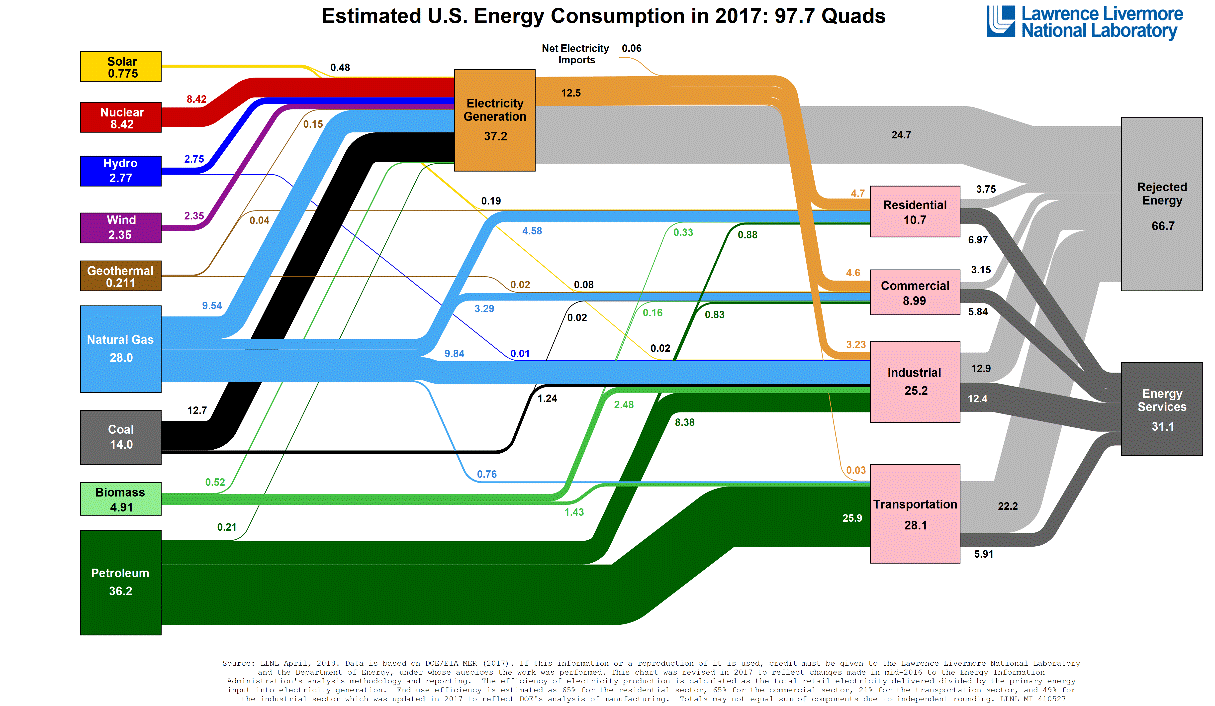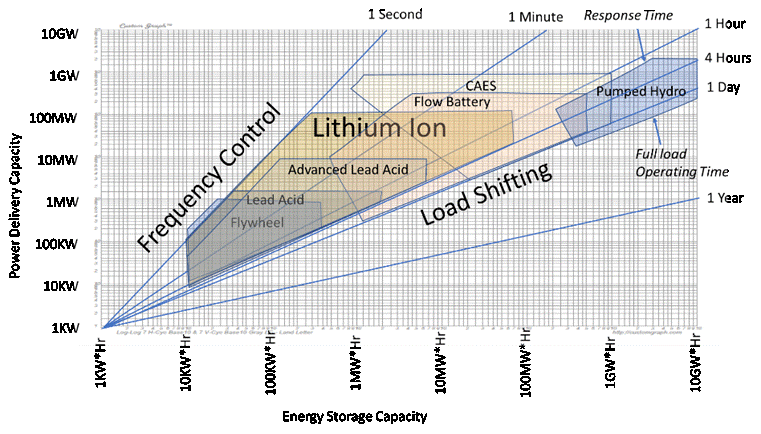

Thanks to massive investments in battery technology in recent decades, battery performance has been increasing, while costs have been coming down. New grid-scale battery storage capabilities have enabled the emergence of microgrids, which typically also incorporate distributed renewable and/or small-scale fossil generation capabilities. However, energy balance charts such as the one included in this post show that we still have a long way to go when it comes to the journey to zero-emission energy sources.
Lawrence Livermore Labs has been producing these energy balance charts for many years. They show that energy generation in the US still largely depends on fossil resources. In the chart, “energy services” in the thermodynamic sense is about converting heat into electricity. Both fossil and nuclear generation require an engine to make useful energy services. The engine is typically a diesel, Rankine (steam), and/or Brayton cycle (gas turbine) to convert heat to work. Here, the efficiency ranges from 25-60%. Energy that is not producing useful work (energy services) is rejected heat energy. In the electric generation sector above, wind, solar, and hydro, make a relatively direct path to energy services as they have little rejected energy. The overall transformation to zero-emissions energy services (generation) is both immensely challenging and highly disruptive.

China is making noteworthy progress transitioning to a renewable energy economy. Currently, it is world's leading country in electricity production from renewable energy sources (36.6% renewable in 2017) with over double the generation of the second-ranking country, the United States. China has sold nearly three times as many electric cars in 2017 as were sold in the US and increasingly dominates the production of electric batteries.
California has recently signed a bill and an executive order establishing the goal to move to zero-emission energy sources for its electricity by 2045. While new efficient lighting and HVAC systems reduce the electric load, the transition to electric cars, trucks, and buses will require an expansion of electric generation. The future of existing coal- and even natural gas-powered electrical generators in California have few options without some form of carbon capture.
The non-dispatchable nature of renewables presents challenges when it comes to maintaining a stable and reliable electric grid worldwide (especially at high penetration levels of renewable generation).

Batteries have been a key component of uninterruptible power suppler (UPS) systems used to maintain reliable power to relatively small critical computing resources for a matter of hours. On a larger scale, lithium batteries are increasingly being employed to store and dispatch grid power when needed. While utilities find batteries may substitute for some peak load generation or take load off overloaded transmission lines, most batteries are at the distribution end of grids where they can combine with distributed generation to form microgrids or nanogrids. As solar penetration increases, states like Hawaii and California are requiring batteries to be part of residential and commercial solar systems to shift load during the peak hours of the day. The resulting micro and nano grids improve resiliency and reliability by providing a system that can operate in island mode, maximize self-consumption, or operate to provide ancillary services when connected to the main grid.
Grid-scale batteries are available from multiple microgrid automation suppliers in standard 10-, 20-, and 40-foot plug-and-play containers, which are essentially complete factory-tested “microgrids in a box” ready to connect to diesel, gas, wind, and solar generation. These microgrids connect to the main grid and local loads.
Our world economy depends on reliable energy for power, transportation, industry, and buildings. Modern society demands reliable electric power, reliable and safe transport of people and goods, the flow of industrial and agricultural products, and comfortable interior environments. With declining battery prices, commercial and residential buildings are increasingly connected to microgrids, especially where power reliability is poor, or the cost of power failures high.
The transportation industry is beginning to transition to electric power. Wang Chuanfu of BYD, a leading lithium battery manufacturer and supplier of electric cars and buses in China, sees all new cars potentially being electric in that country as soon as in 2030. In 2017, China sold 579,000 electric cars while the US sold only 198,350. China, with about a dozen separate EV car manufacturers, is getting lots of experience with the transition to electric transport.
Obviously, new infrastructure is needed to support transport electrification. In the US, the EV charging station market is growing with about 38% CAGR and the Lithium ion battery market is growing at about 31% CAGR. This is massive growth. The coming electrification of the transport sector will be a major source of growth for the power industry. These increased loads are particularly challenging when governments set 100% zero-emissions targets and the average consumer expects utilities to provide all-electric power from emissions-free, sustainable and/or renewable sources without drastically impacting power prices or reliability. Batteries and microgrids will help greatly and smart grid-based demand response has lots of untapped potential. Storing electric energy to meet a two-week cold spell in New England or storing excess summer solar energy for use in the winter currently are unsolved problems without fossil fuels.
For more detailed information, please refer to the ARC study on Microgrid Automation.

